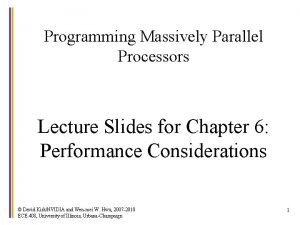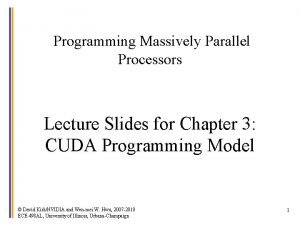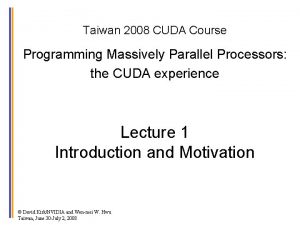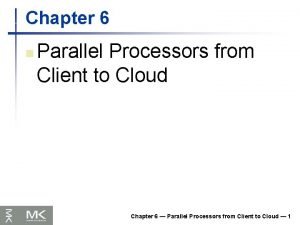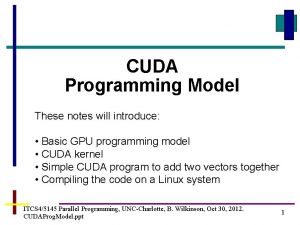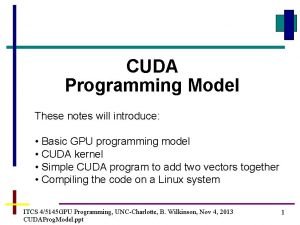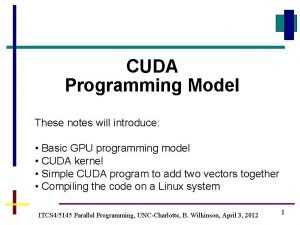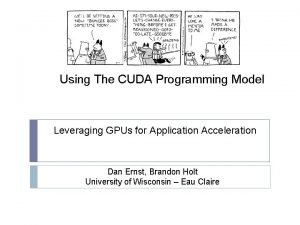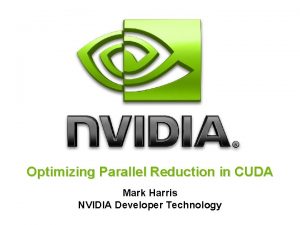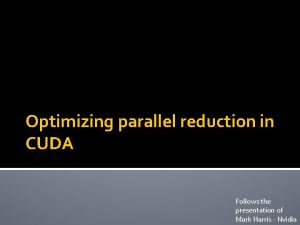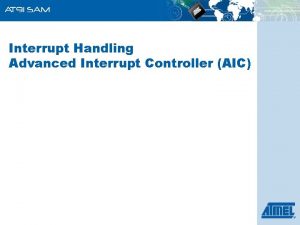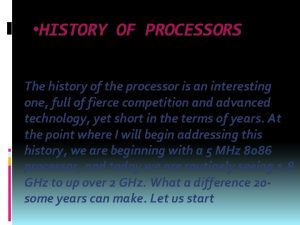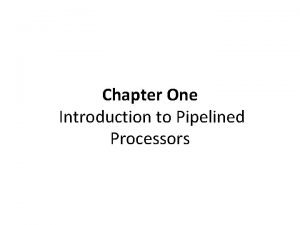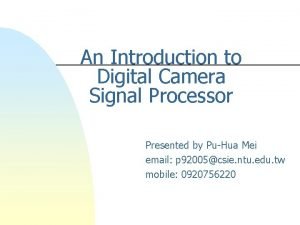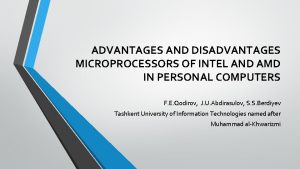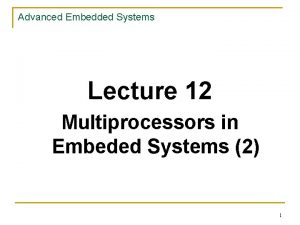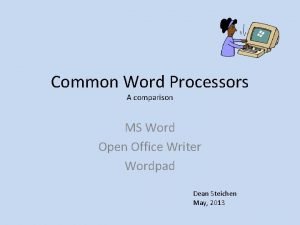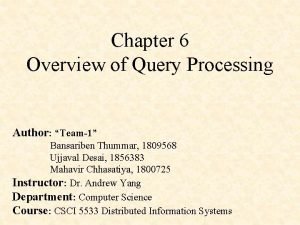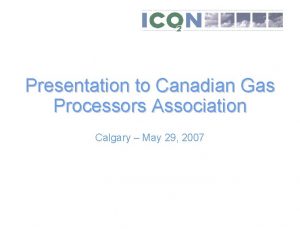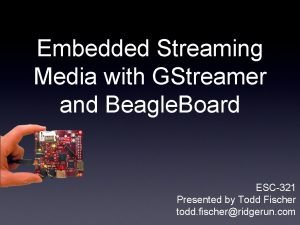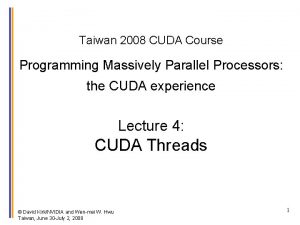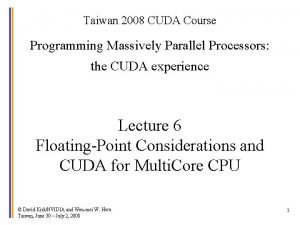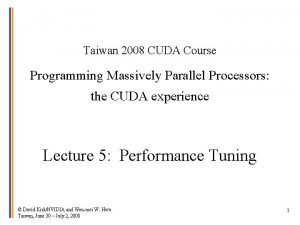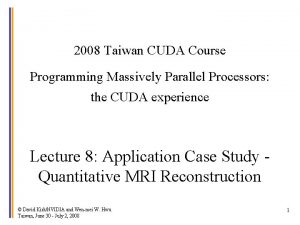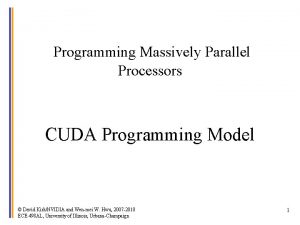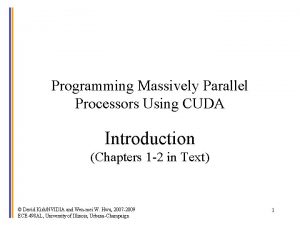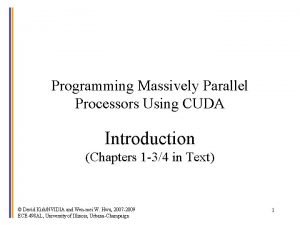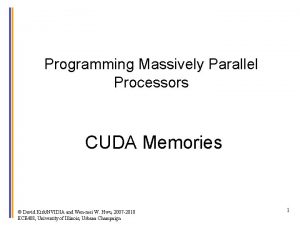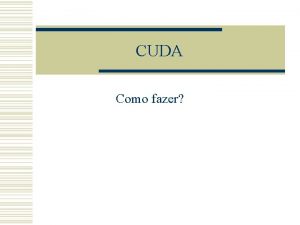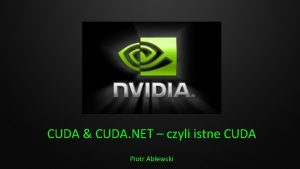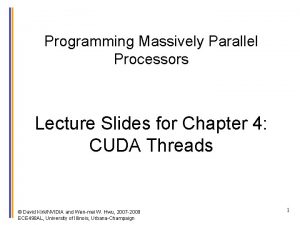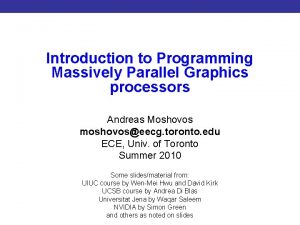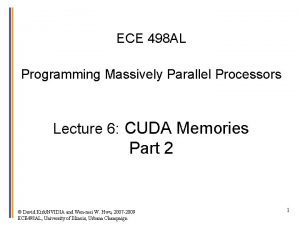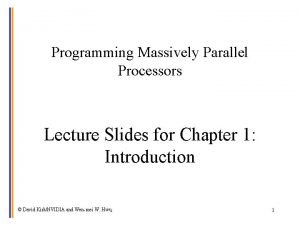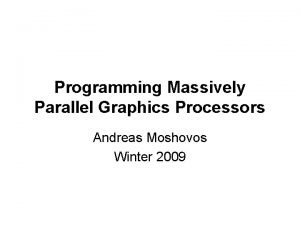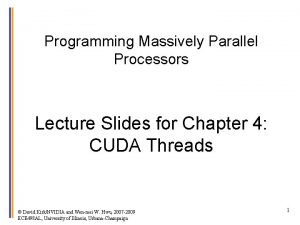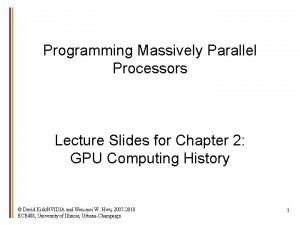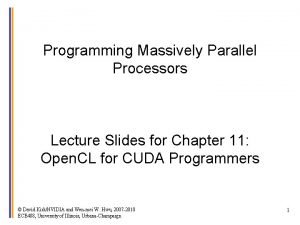Taiwan 2008 CUDA Course Programming Massively Parallel Processors
























- Slides: 24

Taiwan 2008 CUDA Course Programming Massively Parallel Processors: the CUDA experience Lecture 1 Introduction and Motivation © David Kirk/NVIDIA and Wen-mei W. Hwu Taiwan, June 30 -July 2, 2008

What is driving the manycores? 1 Based on slide 7 of S. Green, “GPU Physics, ” SIGGRAPH 2007 GPGPU Course. http: //www. gpgpu. org/s 2007/slides/15 GPGPU-physics. pdf © David Kirk/NVIDIA and Wen-mei W. Hwu Taiwan, June 30 -July 2, 2008

Design philosophies are different. • The GPU is specialized for compute-intensive, massively data parallel computation (exactly what graphics rendering is about) – So, more transistors can be devoted to data processing rather than data caching and flow control Control ALU ALU CPU GPU Cache DRAM • The fast-growing video game industry exerts strong economic pressure for constant innovation © David Kirk/NVIDIA and Wen-mei W. Hwu Taiwan, June 30 -July 2, 2008

This is not your advisor’s parallel computer! • Significant application-level speedup over uni-processor execution – No more “killer micros” • Easy entrance – An initial, naïve code typically get at least 2 -3 X speedup • Wide availability to end users – available on laptops, desktops, clusters, super-computers • Numerical precision and accuracy – IEEE floating-point and double precision © David Kirk/NVIDIA and Wen-mei W. Hwu Taiwan, June 30 -July 2, 2008

GPU Computing Scaling • Laptops, desktops, workstations, servers, clusters – (cell phones? i. Pods? ) • UIUC has built a 16 -node GPU cluster – Peak performance 32. 5 TFLOPS (SP) – For science and engineering apps • Ge. Force 8800 UIUC is planning a 32 -node GPU cluster Tesla D 870 for Summer 2008 – Estimated peak performance 130 TFLOPS (SP) and 16 TFLOPS (DP) • UIUC is designing a 1, 000 -node GPU cluster in 2010 – Projected peak performance of 4 PFLOPS (SP) and 400 TFLOPS (DP) © David Kirk/NVIDIA and Wen-mei W. Hwu Taiwan, June 30 -July 2, 2008 Tesla S 870

How much computing power is enough? • Each 10 X jump in computing power motivates new ways of computing – Many apps have approximations or omissions that arose from limitations in computing power – Every 10 x jump in performance allows app developers to rethink their fundamental assumptions and strategies – Example: graphics, medical imaging, physics simulation, etc. • Each 2 -3 X allows addition new, innovative features to applications © David Kirk/NVIDIA and Wen-mei W. Hwu Taiwan, June 30 -July 2, 2008

Historic GPGPU Movement • General Purpose computation using GPU in applications other than 3 D graphics – GPU accelerates critical path of application • Data parallel algorithms leverage GPU attributes – Large data arrays, streaming throughput – Fine-grain SIMD parallelism – Low-latency floating point (FP) computation • Applications – see //GPGPU. org – Game effects (FX) physics, image processing – Physical modeling, computational engineering, matrix algebra, convolution, correlation, sorting © David Kirk/NVIDIA and Wen-mei W. Hwu Taiwan, June 30 -July 2, 2008

Historic GPGPU Constraints • Dealing with graphics API – Working with the corner cases of the graphics API Input Registers Fragment Program • Addressing modes per thread per Shader per Context Texture Constants – Limited texture size/dimension Temp Registers • Shader capabilities – Limited outputs • Instruction sets Output Registers FB Memory – Lack of Integer & bit ops • Communication limited – No interaction between pixels – No scatter store ability - a[i] = p © David Kirk/NVIDIA and Wen-mei W. Hwu Taiwan, June 30 -July 2, 2008 These have all changed with CUDA!

What is the GPU Good at? • The GPU is good at data-parallel processing • The same computation executed on many data elements in parallel – low control flow overhead with high SP floating point arithmetic intensity • Many calculations per memory access • Currently also need high floating point to integer ratio • High floating-point arithmetic intensity and many data elements mean that memory access latency can be hidden with calculations instead of big data caches – Still need to avoid bandwidth saturation! © David Kirk/NVIDIA and Wen-mei W. Hwu Taiwan, June 30 -July 2, 2008

CUDA - No more shader functions. • CUDA integrated CPU+GPU application C program – Serial or modestly parallel C code executes on CPU – Highly parallel SPMD kernel C code executes on GPU CPU Serial Code Grid 0 GPU Parallel Kernel. A<<< n. Blk, n. Tid >>>(args); . . . CPU Serial Code Grid 1 GPU Parallel Kernel. B<<< n. Blk, n. Tid >>>(args); © David Kirk/NVIDIA and Wen-mei W. Hwu Taiwan, June 30 -July 2, 2008 . . .

It is about applications! Vision, Imaging, VACE, HCI, Modeling and Simulation… © David Kirk/NVIDIA and Wen-mei W. Hwu Taiwan, June 30 -July 2, 2008

Science and Engineering Application Speedup App. Archit. Bottleneck Simult. T Kernel X App X H. 264 Registers, global memory latency 3, 936 20. 2 1. 5 LBM Shared memory capacity 3, 200 12. 5 12. 3 RC 5 -72 Registers 3, 072 17. 1 11. 0 FEM Global memory bandwidth 4, 096 11. 0 10. 1 RPES Instruction issue rate 4, 096 210. 0 79. 4 PNS Global memory capacity 2, 048 24. 0 23. 7 LINPACK Global memory bandwidth, CPU-GPU data transfer 12, 288 19. 4 11. 8 TRACF Shared memory capacity 4, 096 60. 2 21. 6 FDTD Global memory bandwidth 1, 365 10. 5 1. 2 Instruction issue rate 8, 192 23. 0 MRI-FHD Hot. Chips-2007] © [HKR David Kirk/NVIDIA and Wen-mei W. Hwu Taiwan, June 30 -July 2, 2008

Massive Speedup can Cartesian Scan Revolutionize Apps Spiral Scan Data Gridding 1 (b) (a) FFT (b) (c) Iterative Reconstructi Spiral scan data + Gridding + FFT: on Faster scan reduces artifacts, averaging increases SNR. Reconstruction requires little computation. 1 Based on Fig 1 of Lustig et al, Fast Spiral Fourier Transform for Iterative MR Image Reconstruction, IEEE Int’l Symp. on Biomedical Imaging, 2004 © David Kirk/NVIDIA and Wen-mei W. Hwu Taiwan, June 30 -July 2, 2008

Chemo Therapy Monitoring 6 -12 weeks © David Kirk/NVIDIA and Wen-mei W. Hwu Taiwan, June 30 -July 2, 2008

Cartesian Scan Data MRI Reconstruction Spiral Scan Data Gridding (b) (a) FFT (b) (c) Iterative Reconstructi Spiral scan data + Iterative recon: on Fast scan reduces artifacts, iterative reconstruction increases SNR. Reconstruction requires a lot of computation. © David Kirk/NVIDIA and Wen-mei W. Hwu Taiwan, June 30 -July 2, 2008

An Exciting Revolution - Sodium Map of the Brain • Images of sodium in the brain – Requires powerful scanner (9. 4 Tesla) – Very large number of samples for increased SNR – Requires high-quality reconstruction • Enables study of brain-cell viability before anatomic changes occur in stroke and cancer treatment – within Courtesy of Keith Thulborn and Ian Atkinson, Center for MR Research, University of Illinois at Chicago days! © David Kirk/NVIDIA and Wen-mei W. Hwu Taiwan, June 30 -July 2, 2008

Advanced MRI Reconstruction • Q depends only on scanner configuration More than H • F d depends on scan data 99. 5% of time • ρ found using linear solver Compute Q Acquire Data Compute F Hd Find ρ – FHF computed once per iteration; depends on Q, FHd – λWHW incorporates anatomical constraints Reconstruction of a 643 image used to take days! Haldar, et al, “Anatomically-constrained reconstruction from noisy data, ” MR in Medicine. © David Kirk/NVIDIA and Wen-mei W. Hwu Taiwan, June 30 -July 2, 2008

Code for (p = 0; p < num. P; p++) { for (d = 0; d < num. D; d++) { exp = 2*PI*(kx[d] * x[p] + ky[d] * y[p] + kz[d] * z[p]); c. Arg = cos(exp); s. Arg = sin(exp); r. Fh. D[p] += r. Rho[d]*c. Arg – i. Rho[d]*s. Arg; i. Fh. D[p] += i. Rho[d]*c. Arg + r. Rho[d]*s. Arg; } } © David Kirk/NVIDIA and Wen-mei W. Hwu Taiwan, June 30 -July 2, 2008 __global__ void cmp. Fh. D(float* gx, gy, gz, gr. Fh. D, gi. Fh. D) { int p = block. Idx. x * THREADS_PB + thread. Idx. x; // register allocate image-space inputs & outputs x = gx[p]; y = gy[p]; z = gz[p]; r. Fh. D = gr. Fh. D[p]; i. Fh. D = gi. Fh. D[p]; for (int d = 0; d < SCAN_PTS_PER_TILE; d++) { // s (scan data) is held in constant memory float exp = 2 * PI * (s[d]. kx * x + s[d]. ky * y + s[d]. kz * z); c. Arg = cos(exp); s. Arg = sin(exp); r. Fh. D += s[d]. r. Rho*c. Arg – s[d]. i. Rho*s. Arg; i. Fh. D += s[d]. i. Rho*c. Arg + s[d]. r. Rho*s. Arg; } gr. Fh. D[p] = r. Fh. D; gi. Fh. D[p] = i. Fh. D; }

Performance of Fh. D Computation S. S. Stone, et al, “Accelerating Advanced MRI Reconstruction using GPUs, ” ACM Computing Frontier Conference 2008, Italy, May 2008. © David Kirk/NVIDIA and Wen-mei W. Hwu Taiwan, June 30 -July 2, 2008

Final Data Arrangement and Fast Math Performance: 128 GFLOPS Time: 1. 2 minutes © David Kirk/NVIDIA and Wen-mei W. Hwu Taiwan, June 30 -July 2, 2008

Results must be validated by domain experts. © David Kirk/NVIDIA and Wen-mei W. Hwu Taiwan, June 30 -July 2, 2008

CUDA for Multi-Core CPU • A single GPU thread is too small for a CPU Thread – CUDA emulation does this and performs poorly • CPU cores designed for ILP, SIMD – Optimizing compilers work well with iterative loops • Turn GPU thread blocks from CUDA into iterative CPU loops © David Kirk/NVIDIA and Wen-mei W. Hwu Taiwan, June 30 -July 2, 2008

Bigger Picture Performance Results • Consistent speed-up over hand-tuned single-thread code • Best optimizations for GPU and CPU not always the same Application MRI-FHD C on single core CPU Time CUDA on 4 core CPU Time Speedup* CUDA on G 80 Time ~1000 s 230 s ~4 x 8. 5 s 180 s 45 s 4 x . 28 s SAD 42. 5 ms 25. 6 ms 1. 66 x 4. 75 ms MM (4 Kx 4 K) 7. 84 s** 15. 5 s 3. 69 x 1. 12 s CP *Over hand-optimized CPU **Intel MKL, multi-core execution © David Kirk/NVIDIA and Wen-mei W. Hwu Taiwan, June 30 -July 2, 2008

A Great Opportunity for Many • GPU parallel computing allows – Drastic reduction in “time to discovery” – 1 st principle-based simulation at meaningful scale – New, 3 rd paradigm for research: computational experimentation • The “democratization” of power to discover • • $2, 000/Teraflop SPFP in personal computers today $5, 000/Petaflops DPFP in clusters in two years HW cost will no longer be the main barrier for big science You will make the difference! © David Kirk/NVIDIA and Wen-mei W. Hwu Taiwan, June 30 -July 2, 2008
 Programming massively parallel processors
Programming massively parallel processors Programming massively parallel processors
Programming massively parallel processors Massively parallel processing ppt
Massively parallel processing ppt Programming massively parallel processors, kirk et al.
Programming massively parallel processors, kirk et al. Parallel processors from client to cloud
Parallel processors from client to cloud 2008 2008
2008 2008 Cuda programming model
Cuda programming model Cuda programming model
Cuda programming model Cuda programming model
Cuda programming model Cuda programming model
Cuda programming model Parallel reduction cuda
Parallel reduction cuda Optimizing parallel reduction in cuda
Optimizing parallel reduction in cuda Difference between linear and nonlinear pipeline
Difference between linear and nonlinear pipeline Aicarm
Aicarm History of processors
History of processors Classification of pipeline processors
Classification of pipeline processors Digital camera processors
Digital camera processors Advantages of intel processor
Advantages of intel processor Embeded processors
Embeded processors Embedded innovator winter 2010
Embedded innovator winter 2010 Comparison of word processors
Comparison of word processors Layers of query processing
Layers of query processing Gas processors association
Gas processors association Beagleboard embedded processors
Beagleboard embedded processors Network systems design using network processors
Network systems design using network processors

